Tertiary Amines Market Research, 2031
The global tertiary amines market size was valued at $4.3 billion in 2021, and is projected to reach $5.6 billion by 2031, growing at a CAGR of 2.8% from 2022 to 2031.
Tertiary amines are molecules, which contain three C-N bonds, and no N-H bonds. Tertiary amines are vital products in the modern chemical industry. Their common applications include amine oxides, quaternary derivatives, and betaines, which are utilized in industrial, household, and institutional cleaners; personal care; wood treatment; oil field; and water treatment. They are used as intermediates during the production of multiple chemicals, such as fuel oils, cosmetics, surfactants, and citric acid for fabricating metal preservatives, extracting agents, and fungicides. They are widely employed for elimination of the amino group and ammonium salts, and fusion of quaternary replacement reactions. Tertiary amines, such as pyridine, benzyldimethylamine, and imidazole have been extensively used as a base for the synthesis of epoxy resins of Bisphenol A diglycidyl ether (BADGE or DGEBA). They are also used as components of formulated products and intermediate products of myriad specialized chemical derivatives. They are crucial raw materials for manufacturing quaternary ammonium salts.
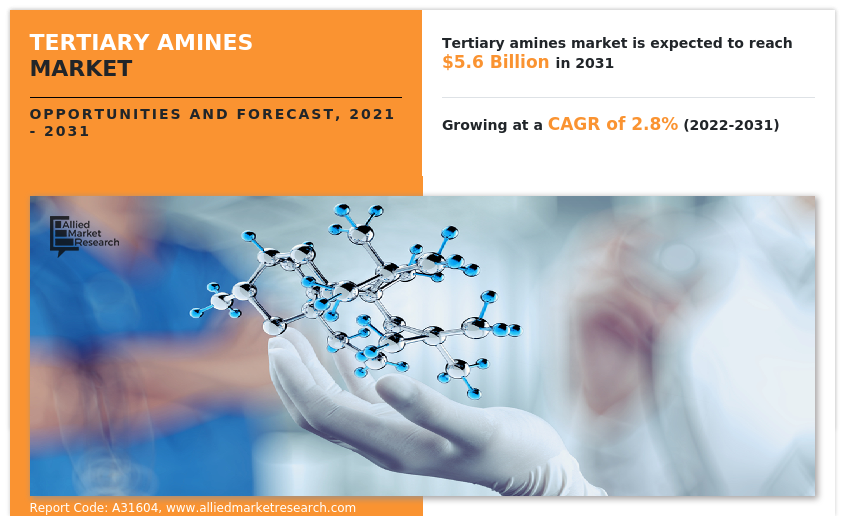
Tertiary amines are primarily used to make tetra derivatives, amine oxides, and betaines, which are used to make household, commercial, and institutional cleansers and disinfectants, as well as products for the treatment of wood, skin care, oil fields, and water. For instance, tertiary amine is used as a starting material in the preparation of pain-relieving pharmaceuticals, such as morphine and demerol. It is also employed in the manufacture of novocaine, which is used as an anesthetic.
As tertiary amines are unstable in nature, they may degrade into toxic chemicals. These degradation products include aldehydes, amides, nitrosamines, nitramines, and others. Amines and their derivatives permeate the air, water, and soil, and they may have a range of environmental consequences. However, tertiary amines are versatile compounds that can accelerate a wide range of organic and oxidation-reactive reactions. Furthermore, tertiary amines have been proven to improve organic pollutant breakdown and water disinfection in water treatment. As a result, numerous sectors, particularly energy-intensive pulp bleaching operations, might profit from speedier reactions involving chloroammonium cations
Increase in demand for tertiary amines from cosmetics & personal care, water treatment, pharmaceuticals, cleaning products and disinfectants, and other industries is expected to serve as a crucial growth factor for the global tertiary amines industry.
Tertiary amines are important products in the modern chemical industry. Tertiary amines are typically utilized in the production of quaternary derivatives, amine oxides, and betaines, which are used in the production of domestic, commercial, and institutional cleaners and disinfectants as well as products for the treatment of wood, skin care, oil fields, and water. Tertiary amines and its derivatives act as biocides due to their ability to kill microorganisms. Disinfectants are necessary in the food business to sanitize kitchens and serve as preservatives. To maintain a clean or sterile working environment, many industrial plants, particularly food plants, fast food restaurants, and institutional facilities make use of biocides. These are frequently used in the textile and apparel industries to make azo dyes, which are essential for treating materials like leather and nylon. Furthermore, they are employed in lubricating oils and boilers as corrosion inhibitors in the chemical processing industries. Tertiary amine plays a significant role in the pharmaceutical industry as it is widely used in the preparation of drugs. For instance, drugs like morphine and Demerol, which act as pain relieving medications are prepared by using tertiary amine as a starting material. Similarly, it is utilized in the preparation of novocaine, which is used as anesthetic.
Further, rising demand from cosmetics & personal care industry is another key factor that fosters the market growth during the forecast period. Tertiary amines and its derivatives are widely used in the cosmetics and personal care industry. Triethanolamine (TEA or TEOA) is an organic chemical compound that is both, a triol and a tertiary amine. TEA is a bi-functional substance that possesses both the characteristics of amines and alcohols. The substance is utilized in the production of surfactants in cosmetics as a pH adjuster for skin and hair conditioning products as well as sunblock lotions and polishes. It also encourages the creation of close mixes of immiscible liquids by adjusting the interfacial tension in various personal care products. Triethanolamine being highly acidic is employed as synthetic emulsion agent in personal care products. Tertiary amines are also used in liquid soaps, shampoos, and dyes.
However, toxic nature of tertiary amines is anticipated to hamper the growth of the global tertiary amines market. Tertiary amine catalysts are frequently used in foundry and polyurethane foam manufacturing processes. Graphic visual abnormalities and systemic health problems have been linked to these highly reactive amines. On the contrary, surge in water treatment activities is expected to generate lucrative opportunities for the growth of the global tertiary amines market.
The tertiary amines market is segmented into product type, application, end-use industry, and region. On the basis of product type, the market is categorized into C-8 TA, C-10 TA, C-12 TA, C-14 TA, C-16 TA, and others. On the basis of application, the market is categorized into surfactants, biocides, and others. On the basis of end-use industry, the market is categorized into cosmetics & personal care, water treatment, pharmaceuticals, cleaning products and disinfectants, and others. Region-wise, the tertiary amines market share is studied across North America, Europe, Asia-Pacific, and LAMEA.
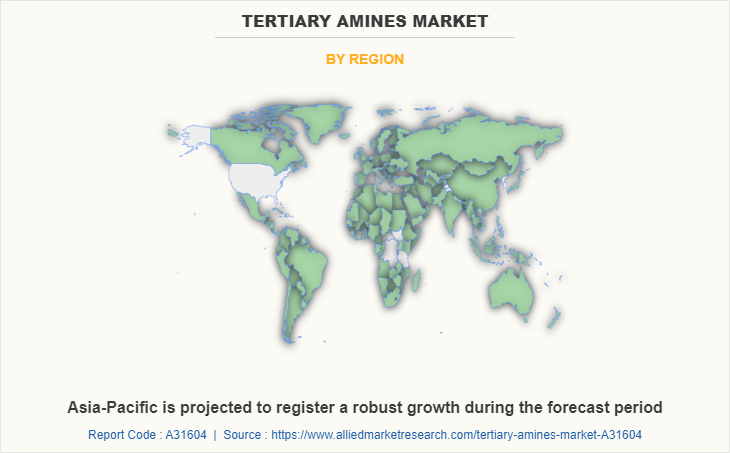
Asia-Pacific is projected to register a robust growth during the forecast period. Tertiary amines are mostly utilized in agricultural chemicals, such as herbicides to control weeds, fungicides to control diseases, and insecticides to control pests. Tertiary amines are used in wood treatment in Asia-Pacific to alleviate wood degradation issues caused by fungal rot or decay, sapstain, molds, or wood-destroying insects, as well as to extend the life of the wood. It kills fungi that cause wet rot and dry rot in wood. The increasing use of tertiary amines in agricultural chemicals and cleaning products is expected to drive the Asia-Pacific market growth.
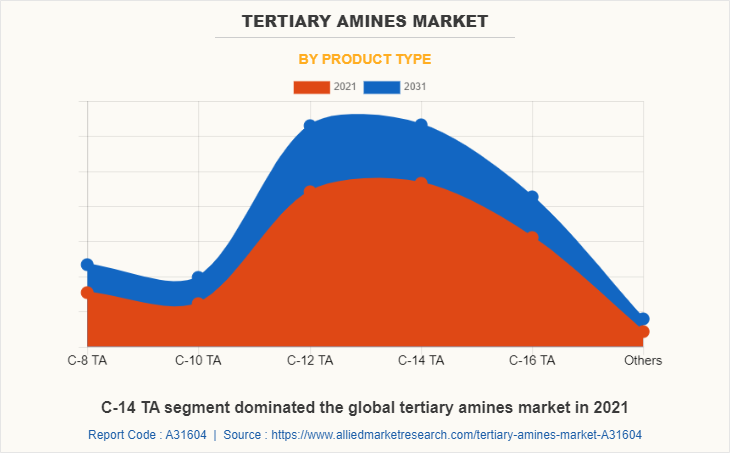
C-14 TA segment dominated the global tertiary amines market in 2021. In emulsification, C-14 tertiary amines are employed to stabilize the emulsion state by suppressing emulsion disintegration caused by creaming, aggregation, and coalescence. C-14 tertiary amines are utilized as anticaking agents, which are additives used in powdered or granular commodities like table salt or confectioneries to prevent lump formation (caking) and enhance packaging, transport, flowability, and consumption.
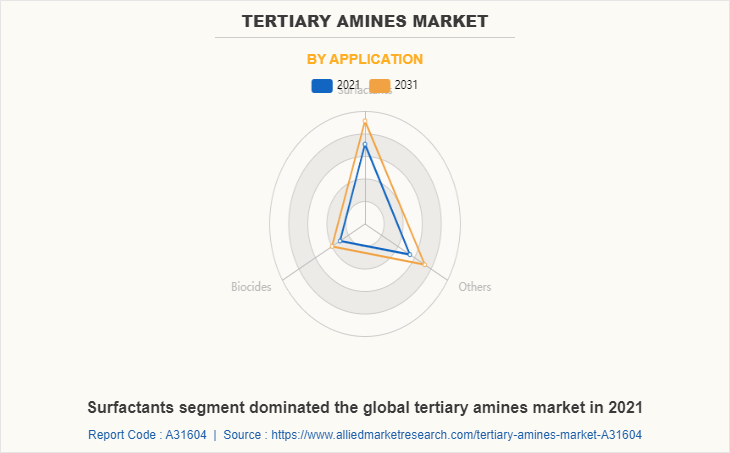
Surfactants segment dominated the global tertiary amines market in 2021. Surfactants are essential components of cleansing, wetting, dispersing, emulsifying, foaming, and anti-foaming agents. Herbicides, insecticides, biocides (sanitizers), and spermicides are examples of agrochemical formulations. Surfactants can also be found in lubricants, inks, anti-fogging solutions, herbicides, adhesives, emulsifiers, and fabric softeners. Surfactants, known as pulmonary surfactants, are even produced by the human body.
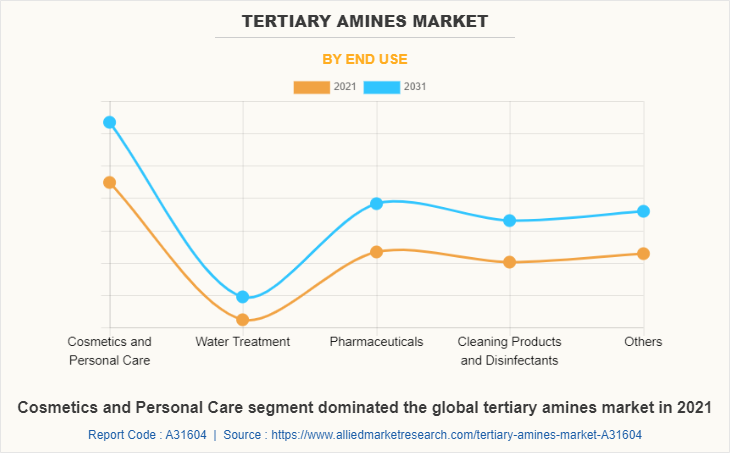
Cosmetics and Personal Care segment dominated the global tertiary amines market in 2021. Tertiary amines can be found in a variety of personal care items, such as sanitizers, sunscreen lotion, and more. Cosmetics are typically leave-on items that remain on the skin for several hours, such as body and face creams, insect repellants, cosmetics, fragrances, and antiperspirants. Tertiary amines have grown in the field of personal care and cosmetics, which includes products applied to the external parts of the body such as skin, nails, hair, lips, and external genital organs, as well as dental care such as teeth and mucous membrane of the oral cavity, to clean, protect from pathogens, and prevent bad odor.
Key Players and Strategies:
The major players operating in the global tertiary amines market include, Albemarle Corporation, Kao Corporation, Eastman Chemical Company, Arkema, Solvay, BASF SE, Huntsman International LLC, DuPont, Alkyl Amines Chemicals, and Limited Hexion Inc.
These players have been adopting numerous key strategies to retain leading positions in the market. Expansion, acquisition, new product launches, and collaboration are the most adopted strategies by these players. For instance, in 2022, BASF announced the expansion of manufacturing capacity at its Geismar, Louisiana facility for critical specialty amines. BASF will be able to create more of its major polyetheramines and tertiary amines sold under the Baxxodur and LupragenT names after the completion of a flexible world-scale manufacturing infrastructure by mid-2023. North American assets will be added to a global network of specialty amines production units, including Verbund locations in Ludwigshafen, Germany, Nanjing, and China.
In 2021, Kao Corporation announced intentions to construct a new tertiary amine manufacturing plant in Pasadena, Texas, primarily to fulfill increased demand for sterilizing/cleaning applications, but also for various other industrial uses. Kao Corporation increased output at its Philippines location by 10,000 tonnes per year in 2021 and aims to increase production at its Germany plant by 20,000 tons per year in 2022.
Historical Trends:
Tertiary amine production has been linked to wastewater-impacted waters, although precise precursors found in wastewater effluents were not discovered until 2010. Tertiary amines are gradually being employed in drinking water, industrial water supply, irrigation, river flow maintenance, water recreation, and a variety of other applications, including being safely returned to the environment. In 2014, tertiary amines were replaced with linear aliphatic chains ranging in length from 8 to 12 carbon atoms, which were then employed in the personal care and cosmetics industries. Personal care product sales increased by roughly $1.51 billion in the quarter period.
COVID-19 analysis:
The COVID-19 pandemic had major impact on the global tertiary amines market. The tertiary amine is widely used for quaternary replacement reaction fusion and amino group removal. During the coronavirus crisis, disinfection demand surged, thereby propelling the tertiary amines market growth. This has benefited the tertiary amines market as these amines are widely used in sanitizers and disinfection wipes. The coronavirus impact and the requirement to maintain virus-free surfaces are likely to play an important role in boosting the tertiary amines industry. Many sanitizers, wipes, sprays, and liquid dish soap include quaternary ammonium compounds, which function against viruses by stripping them of their lipid sheath, rendering them unable to infiltrate cells. Further, cleaning product sales increased in the first week of March 2020 in the U.S. As customers prepared for the coronavirus, sales of aerosol disinfectants, in particular, increased by about 400% in 2019.
Key Benefits For Stakeholders
- This report provides a quantitative analysis of the market segments, current trends, estimations, and dynamics of the tertiary amines market analysis from 2021 to 2031 to identify the prevailing tertiary amines market opportunities.
- The market research is offered along with information related to key drivers, restraints, and opportunities.
- Porter's five forces analysis highlights the potency of buyers and suppliers to enable stakeholders make profit-oriented business decisions and strengthen their supplier-buyer network.
- In-depth analysis of the tertiary amines market segmentation assists to determine the prevailing market opportunities.
- Major countries in each region are mapped according to their revenue contribution to the global market.
- Market player positioning facilitates benchmarking and provides a clear understanding of the present position of the market players.
- The report includes the analysis of the regional as well as global tertiary amines market trends, key players, market segments, application areas, and market growth strategies.
Tertiary amines Market Report Highlights
| Aspects | Details |
| Market Size By 2031 | USD 5.6 billion |
| Growth Rate | CAGR of 2.8% |
| Forecast period | 2021 - 2031 |
| Report Pages | 368 |
| By Product Type |
|
| By Application |
|
| By End Use |
|
| By Region |
|
| Key Market Players | Hexion Inc., Albemarle Corporation, DuPont de Nemours, Inc., Arkema, Solvay, Huntsman International LLC, Alkyl Amines Chemicals Limited, Kao Corporation, Eastman Chemical Company, BASF SE |
Analyst Review
According to the perspective of the CXOs of leading companies, the global tertiary amines market is anticipated to grow in the near future due to its extensive use in applications, such as surfactants, biocides, and others. Surfactants derived from tertiary amines have an essential role in cleaning, wetting, dispersing, emulsifying, foaming, and anti-foaming agents. It is found in a variety of agrochemical formulations, including herbicides (in certain cases), insecticides, biocides (sanitizers), and spermicides.
Surfactants help in emulsification, foaming, wetting, and thickening, and their ability to change surfaces provides benefits like softening, corrosion inhibition, adhesion, anti-static characteristics, lubrication, and hydrophobation. Surfactants with poor aqueous solubility cause flocculation, ion exchange, and decolorization, which have applications in fields as diverse as water treatment, sugar refining, and the synthesis of organoclays. Tertiary amine surfactants, are added to cleaning agents, such as detergent, which allow the detergent to combine with water, assisting cleaning agents in removing impurities from the surface being cleaned. Surfactants are also found in lubricants, such as shaving cream, where they allow razors to easily remove stubble while reducing irritation. Thus, the wide application of tertiary amines is predicted to bolster the market growth during the forecast period. Further, the Asia-pacific region is projected to register a robust growth during the forecast period.
The global tertiary amines market was valued at $4.3 billion in 2021, and is projected to reach $5.6 billion by 2031, registering a CAGR of 2.8% from 2022 to 2031.
The growth of the global tertiary amines market is majorly attributed to its wide applications in surfactants, biocides, and others. Also, rising demand from cosmetics & personal care industry is predicted to drive the market growth during the forecast period.
Surfactants is the leading application of Tertiary amines Market.
Asia-Pacific is the largest regional market for Tertiary amines.
The major players operating in the global tertiary amines market include, Albemarle Corporation, Kao Corporation, Eastman Chemical Company, Arkema, Solvay, BASF SE, Huntsman International LLC, DuPont, Alkyl Amines Chemicals, and Limited Hexion Inc.
Loading Table Of Content...



